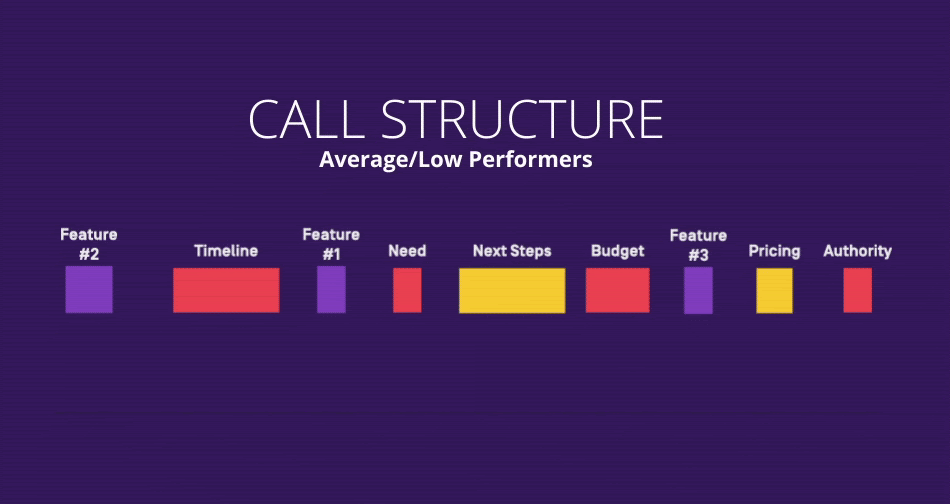Mastering value selling: the key elements of a stellar product demo
Confession: Before COVID, I had to stop going to Costco.
The free samples were amazing and they made me buy more. (And more. And more.)
Well played, Costco. Well played.
When you conduct a demo, you want the same thing to happen. You want the product to sell itself with just one taste.
Your goal is for the demo to be short, controlled, and concise. (No more than nine minutes, btw. Here’s why.)
You’re not there to ask questions. You’re there to prompt them to ask questions.
That means you have to get out of the way pretty quickly and let the product take centre stage.
Let’s take a look at how this played out in the more than 3 million recorded product demos we analyzed using anonymized data from our Gong platform.
Wins begin in discovery
A common feature we saw across winning demos is that they were backed by good discovery calls.
A good discovery call gives you a sense of the buyer’s problem.
This is why they’re so important to value-based selling.
(In fact, we wrote a whole blog about how to conduct them really well. Here it is.)
The two most important questions answered by a good discovery call are:
- What problem does the buyer need to solve?
- How does your product solve that problem?

When you’re ready to demo, that’s where you begin. Recap their problem and how your product solves it, then let them ask questions so the conversation can unfold from there.
According to our data, that’s the skill that top salespeople master.
Anything else makes the sales process complex and muddies the waters you’re trying to make crystal clear.
As a mentor of mine once said, “Simplicity sells, complexity kills.”
Here’s what you’re aiming for:
“<Buyer name>, let me show you exactly how <name of your product> solves <problem>.”
Get in, get out, get back to closing. You can find more sales demo examples here.
How to avoid complexity
What exactly can make a demo too complex?
Talking about the product from a technical standpoint. That’s when you’re selling features.
You want to move to selling value.
When you err on the side of short and simple, you’re headed in the right direction: value selling. That’s the right place to be.
That this doesn’t mean the shorter the better.
It means the more precise the better.
Picture what you currently think of as a good demo. Now picture a stripped down version of it.
That means no features talk, just clear points about their main issue and how your product solves it.
For example, a Gong demo sounds something like this:
“<Buyer name>, you mentioned that you need to understand how your salespeople can convert more deals from discovery to demo when selling to CMOs, VPs of Marketing and Marketing Directors. Here’s exactly how you use our software to see the relevant data and barriers.”
This is where good sellers, indeed good demos, become great.
Train before you demo
A simple and straightforward demo is the reigning champ of value-based selling. It allows buyers to focus on the product’s value, not its features.
This point is an absolute must in your team training.
We’re actually hosting a panel discussion with our friends at Pre-Sales Collective about this. Check it out here.
The main thing your team needs to remember is this: Let buyers understand the value of your product by “tasting” it.
Let them see exactly how it plays out in their world and makes their lives better. Easier. More cash-infused.
Most reps won’t know how to sell this way instinctively, and that’s okay. All it takes is a great starter deck and training on how to use it.
The more time you spend making your sales demo easy to deliver and easy to absorb, the more dividends you’ll reap.
How exactly do you do that?”
Enter stage left, training. Enter stage right, Gong. When they meet in the middle… you’ve got unstoppable demos.
Psssst: Wanna know what makes a sales demo actually sell? Check out this blog we wrote. It’s data-backed.
Get the scoop on every demo
If you want to make this shift in your demos, you’re going to need some intel first:
- What’s the voice of your market really saying?
- Which value-based phrases do buyers respond well to?
- Which of your reps are talking about features vs discovery?
And that intel? It’s sitting inside every demo that takes place on your team.
If you use the right software, you can move from “I’m doing hours of analysis and still coming up short on intel” to “I see everything I need to know in one or two clicks.”
You can get insights into every demo taking place on your team.
Gong applies AI and machine learning to the sales conversations happening on your team, including those at the demo stage.
You’ll get insights into where reps are doing well and where they need help. Use it to reshape your demo into its best self. Objectively. No opinions, only data.
How can you hone your demo craft by hearing and reflecting the voice of your market in your demos?
Gong’s got your back.
Where can you find the exact words, phrases, and details your buyers need to hear?
Gong’s got your back.
How can you turn diluted pitching into highly concentrated, value-driven product demos?
You get the picture.
